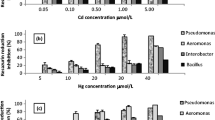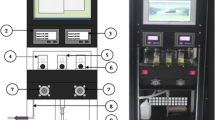Abstract
Here, we present a new toxicity bioassay (CO2-TOX), able to detect toxic or inhibitory compounds in water samples, based on the quantification of Pseudomonas putida KT2440 CO2 production. The metabolically produced CO2 was measured continuously and directly in the liquid assay media, with a potentiometric gas electrode. The optimization studies were performed using as a model toxicant 3,5-DCP (3,5-dichlorophenol); later, heavy metals (Pb2+, Cu2+, or Zn2+) and a metalloid (As5+) were assayed. The response to toxics was evident after 15 min of incubation and at relatively low concentrations (e.g., 1.1 mg/L of 3,5-DCP), showing that the CO2-TOX bioassay is fast and sensitive. The EC50 values obtained were 4.93, 0.12, 6.05, 32.17, and 37.81 mg/L for 3,5-DCP, Cu2+, Zn2+, As5+, and Pb2+, respectively, at neutral pH. Additionally, the effect of the pH of the sample and the use of lyophilized bacteria were also analyzed showing that the bioassay can be implemented in different conditions. Moreover, highly turbid samples and samples with very low oxygen levels were measured successfully with the new instrumental bioassay described here. Finally, simulated samples containing 3,5-DCP or a heavy metal mixture were tested using the proposed bioassay and a standard ISO bioassay, showing that our test is more sensible to the phenol but less sensible to the metal mixtures. Therefore, we propose CO2-TOX as a rapid, sensitive, low-cost, and robust instrumental bioassay that could perform as an industrial wastewater-process monitor among other applications.







Similar content being viewed by others
References
Bonetto, M. C., Sacco, N. J., Hilding-Ohlsson, A., & Cortón, E. (2012). Metabolism of Klebsiella pneumoniae freeze-dried cultures for the design of BOD bioassays. Letters in Applied Microbiology, 55(1), 370–375.
Campanella, L., Favero, G., Mastrofini, D., & Tomassetti, M. (1997). Further developments in toxicity cell biosensors. Sensors and Actuator B: Chemical, 44(1-3), 279–285.
Catterall, K., Robertson, D., Hudson, S., Teasdale, P. R., Welsh, D. T., & John, R. (2010). A sensitive, rapid ferricyanide-mediated toxicity bioassay developed using Escherichia coli. Talanta, 82(2), 751–757.
Chiappini, S. A., Kormes, D. J., Bonetto, M. C., Sacco, N., & Cortón, E. (2010). A new microbial biosensor for organic water pollution based on measurement of carbon dioxide production. Sensors Actuators B: Chemical, 148(1), 103–109.
Cortón, E., Kocmur, S., Haim, L., & Galagovsky, L. (2000). Potentiometric determination of CO2 concentration in the gaseous phase: applications in different laboratory activities. Journal of Chemical Education, 77(9), 1188–1191.
Dalzell, D. J. B., Alte, S., Aspichueta, E., de la Sota, A., Etxebarria, J., Gutiérrez, M., Hoffmann, C. C., Sales, D., Obst, U., & Christofi, N. (2002). A comparison of five rapid direct toxicity assessment methods to determine toxicity of pollutants to activated sludge. Chemosphere, 47(5), 535–545.
Durrieu, C., & Tran-Minh, C. (2002). Optical algal biosensor using alkaline phosphatase for determination of heavy metals. Ecotoxicology and Environmental Safety, 51(3), 206–209.
Fulladosa, E., Murat, J. C., & Villaescusa, I. (2005). Effect of cadmium(II), chromium(VI), and arsenic(V) on long-term viability and growth-inhibition assays using Vibrio fischeri marine bacteria. Archives of Environmental Contamination and Toxicology, 49(3), 299–306.
Fulladosa, E., Murat, J. C., Martínez, M., & Villaescusa, I. (2004). Effect of pH on arsenate and arsenite toxicity to luminescent bacteria (Vibrio fischeri). Archives of Environmental Contamination and Toxicology, 46(2), 176–182.
Gutiérrez, M., Etxebarria, J., & de las Fuentes, L. (2002). Evaluation of wastewater toxicity: comparative study between Microtox® and activated sludge oxygen uptake inhibition. Water Research, 36(4), 919–924.
Hsieh, C. Y., Tsai, M. H., Ryan, D. K., & Pancorbo, O. C. (2004). Toxicity of the 13 priority pollutant metals to Vibrio fisheri in the Microtox® chronic toxicity test. Science of the Total Environment, 320(1), 37–50.
Hudson-Edwards, K. A., Macklin, M. G., Miller, J. R., & Lechler, P. J. (2001). Sources, distribution and storage of heavy metals in the Río Pilcomayo, Bolivia. Journal of Geochemical Exploration, 72(3), 229–250.
ISO 10712. (1995). Water Quality – Pseudomonas putida Growth Inhibition Test (Pseudomonas cell multiplication inhibition test). Geneva, Switzerland: International Organization for Standardization.
ISO 11348–3. (2007). Water Quality – Determination of the Inhibitory Effect of Water Samples on the Light Emission of Vibrio fischeri (Luminescent bacteria test). Geneva, Switzerland: International Organization for Standardization.
Kilroy, A., & Gray, N. F. (1995). Treatability, toxicity and biodegradability test methods. Biological Reviews of the Cambridge Philosophical Society, 70(2), 243–275.
Lappalainen, J., Juvonen, R., Vaajasaari, K., & Karp, M. (1999). New flash method for measuring the toxicity of solid and colored samples. Chemosphere, 38(5), 1069–1083.
Lopez-Roldan, R., Kazlauskaite, L., Ribo, J., Riva, M. C., González, S., & Cortina, J. L. (2012). Evaluation of an automated luminescent bacteria assay for in situ aquatic toxicity determination. Science of the Total Environment, 440, 307–313.
Macklin, M. G., Payne, I., Preston, D., & Sedgwick, C. (1996). Review of the Porco mine tailings dam burst and associated mining waste problems, Pilcomayo basin, Bolivia. Report to UK Overseas Development Administration, p. 33.
Mahendran, B., Choi, N.-C., Choi, J.-W., & Kim, D.-J. (2006). Effect of dissolved oxygen regime on growth dynamics of Pseudomonas spp during benzene degradation. Applied Microbiology and Biotechnology, 71(3), 350–354.
Miller, J. R., Lechler, P. J., Macklin, G., Germanoski, D., & Villarroel, L. F. (2007). Evaluation of particle dispersal from mining and milling operations using lead isotopic fingerprinting techniques, Rio Pilcomayo Basin, Bolivia. Science of the Total Environment, 384(1-3), 355–373.
Miyamoto-Shinohara, Y., Sukenobe, J., Imaizumi, T., & Nakahara, T. (2006). Survival curves for microbial species stored by freeze-drying. Cryobiology, 52(1), 27–32.
Muñoz-Rojas, J., Bernal, P., Duque, E., Godoy, P., Segura, A., & Ramos, J. L. (2006). Involvement of cyclopropane fatty acids in the response of Pseudomonas putida KT2440 to freeze-drying. Applied and Environmental Microbiology, 72(1), 472–477.
OECD Method 209. (2010). OECD Guideline for the Testing of Chemicals: Activated Sludge, Respiration Inhibition Test (ASRIT). Paris, France: Organisation for Economic Cooperation and Development.
Penttinen, O. P. (1995). Chlorophenols in aquatic environments: structure-activity correlations. Annales Zoologici Fennici, 32, 287–294.
Plata, M. R., Contento, A. M., Villaseñor, M. J., Cabezas, M. L., & Ríos, A. (2009). Development of a novel biotoxicity screening assay for analytical use. Chemosphere, 76(7), 959–966.
Pollice, A., Rozzi, A., Tomei, M. C., Di Pinto, A. C., & Laera, G. (2001). Inhibiting effects of chloroform on anaerobic microbial consortia as monitored by the Rantox biosensor. Water Research, 35(5), 1179–1190.
Ricco, G., Tomei, M. C., Ramadori, R., & Laera, G. (2004). Toxicity assessment of common xenobiotic compounds on municipal activated sludge: comparison between respirometry and Microtox. Water Research, 38(8), 2103–2110.
Rizzo, L. (2011). Bioassays as a tool for evaluating advanced oxidation processes in water and wastewater treatment. Water Research, 45(15), 4311–4340.
Rosen, G., Osorio-Robayo, A., Rivera-Duarte, I., & Lapota, D. (2008). Comparison of bioluminescent dinoflagellate (QwikLite) and bacterial (Microtox) rapid bioassays for the detection of metal and ammonia toxicity. Archives of Environmental Contamination and Toxicology, 54(4), 606–611.
Schmitz, R. P. H., Eisenträger, A., & Dott, W. (1998). Miniaturized kinetic growth inhibition assays with Vibrio fischeri and Pseudomonas putida (application, validation and comparison). Journal of Microbiological Methods, 31(3), 159–166.
Smolders, A. J. P., Lock, R. A. C., Van der Velde, G., Medina Hoyos, R. I., & Roelofs, J. G. M. (2003). Effects of mining activities on heavy metal concentrations in water, sediment, and macroinvertebrates in different reaches of the Pilcomayo River, South America. Archives of Environmental Contamination and Toxicology, 44(3), 314–323.
Tan, T. C., & Lim, E. W. C. (2005). Thermally killed cells of complex microbial culture for biosensor measurement of BOD of wastewater. Sensors Actuators B: Chemical, 107(2), 546–551.
Tizzard, A., Webber, J., Gooneratne, R., John, R., Hay, J., & Pasco, N. (2004). MICREDOX: application for rapid biotoxicity assessment. Analytica Chimica Acta, 522(2), 197–205.
Tothill, I. E., & Turner, A. P. F. (1996). Developments in bioassay methods for toxicity testing in water treatment. Trends in Analytical Chemistry, 15(5), 178–188.
Tzoris, A., Fernandez-Perez, V., & Hall, E. A. H. (2005). Direct toxicity assessment with a mini portable respirometer. Sensors Actuators B: Chemical, 105(1), 39–49.
Van Beelen, P., & Fleuren-Kemilä, A. K. (1997). Influence of pH on the toxic effects of zinc, cadmium, and pentachlorophenol on pure cultures of soil microorganisms. Environmental Toxicology and Chemistry, 16(2), 146–153.
Wang, X., Liu, M., Wang, X., Wu, Z., Yang, L., Xia, S., Chen, L., & Zhao, J. (2013). p-Benzoquinone-mediated amperometric biosensor developed with Psychrobacter sp. for toxicity testing of heavy metals. Biosensors and Bioelectronics, 41, 557–562.
Wenfeng, S., Gooneratne, R., Glithero, N., Weld, R. J., & Pasco, N. (2013). Appraising freeze-drying for storage of bacteria and their ready access in a rapid toxicity assessment assay. Applied Microbiology and Biotechnology, 97(23), 10189–10198.
Yong, D., Liu, L., Yu, D., & Dong, S. (2011). Development of a simple method for biotoxicity measurement using ultramicroelectrode array under non-deaerated condition. Analytica Chimica Acta, 701(2), 164–168.
Zosel, J., Oelβner, W., Decker, M., Gerlach, G., & Guth, U. (2011). The measurement of dissolved and gaseous carbon dioxide concentration. Measurement Science and Technology, 22(7), 1–45.
Acknowledgments
This project was funded by the Consejo Nacional de Investigaciones Científicas y Tecnológicas (CONICET) and the Agencia Nacional de Promoción Científica y Tecnológica (AGENCIA); we also want to acknowledge the support of the Subsecretaría de Recursos Hídricos de la Nación (Dr. Andrés Rodríguez), y la Dirección Ejecutiva de la Comisión Trinacional para el Desarrollo de la Cuenca del río Pilcomayo (Ing. Claudio Laboranti). We want to thank Ms. Silvia Rodriguez for the English edition.
Author information
Authors and Affiliations
Corresponding author
Electronic supplementary material
Below is the link to the electronic supplementary material.
ESM 1
(DOCX 2459 kb)
Rights and permissions
About this article
Cite this article
Figueredo, F., Abrevaya, X.C. & Cortón, E. A new P. putida instrumental toxicity bioassay. Environ Monit Assess 187, 294 (2015). https://doi.org/10.1007/s10661-015-4499-1
Received:
Accepted:
Published:
DOI: https://doi.org/10.1007/s10661-015-4499-1




